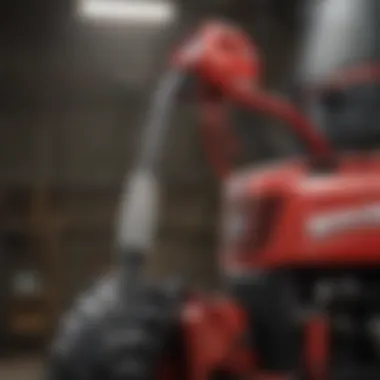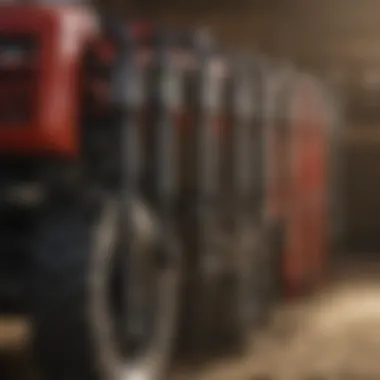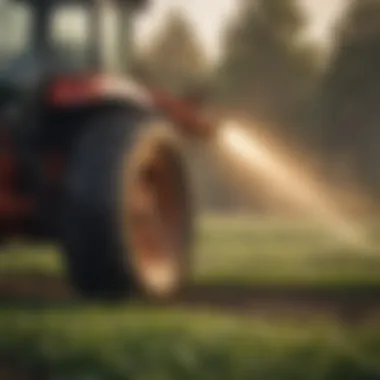Understanding Tractor Supply Sprayer Wands


Intro
In the farming and agricultural sector, efficiency is paramount. One of the essential tools aiding in this efficiency is the sprayer wand. The Tractor Supply sprayer wand represents a practical solution for various applications in agriculture, ensuring that farmers achieve optimal results in tasks like crop protection, fertilization, and pest control. This guide aims to dissect the numerous facets of the Tractor Supply sprayer wand, from its design elements to its functionality in different agricultural contexts.
An understanding of sprayer wands involves grasping key concepts and terminology related to their construction and purpose. In addition to this, recognizing recent innovations informs farmers about the tools available to them today. Practical application techniques will also be discussed, providing a roadmap to successfully utilize these wands in everyday agricultural tasks.
This comprehensive exploration is not merely informative; it serves as a foundation for improving the overall spraying efficiency on farms, thereby contributing to better yields and sustainable practices.
Prelims to Sprayer Wands
Sprayer wands are not simply tools; they are essential instruments in the realm of agriculture. Their proper understanding can greatly enhance spraying efficiency and effectiveness. Sprayer wands serve a crucial purpose, allowing precise application of fertilizers, pesticides, and herbicides. By understanding their features and functions, users can make informed choices on what sprayer wand best fits their operational needs.
Defining Sprayer Wands
A sprayer wand is a handheld or attachment device used with various sprayer systems. Its primary function is to apply liquids in a controlled manner. Sprayer wands come in different designs and types, each tailored for specific spraying tasks. The construction usually includes a nozzle, trigger for flow control, and an extension for reach. This simplicity in design belies the advanced engineering that underpins its operation.
Importance in Agriculture
In agriculture, the rôle of sprayer wands cannot be overstated. They contribute to the overall health of crops by ensuring that necessary treatments are applied accurately. The ability to adjust spray patterns and control flow rates directly affects the efficiency of applications.
- Factors that highlight the importance include:
- Precision in application leads to better crop yields.
- Reduction of chemical runoff helps protect the environment.
- Customizable designs cater to various crop types and growth stages.
By utilizing the right sprayer wand, farmers not only protect their crops but also contribute to sustainable agricultural practices. Understanding how these tools function will empower farm operators to improve crop management and resource allocation.
Types of Sprayer Wands
Understanding the various types of sprayer wands is crucial for effective agricultural practices. Each type serves a distinct purpose and offers specific advantages suited to diverse tasks. This section aims to clarify these variations, helping users make informed choices based on their requirements.
Manual Sprayer Wands
Manual sprayer wands are basic yet effective tools used widely in agricultural settings. These wands require human effort to operate, often employing a pump mechanism to create pressure. The simplicity of manual sprayer wands allows for greater control over the spraying process. They are particularly useful for small-scale gardening or in areas where electricity is unavailable.
Benefits of Manual Sprayer Wands
- Low Cost: They are more affordable than electric or battery-powered options.
- Simplicity: No need for batteries or power sources means fewer technical issues.
However, the physical exertion required can be tiring, especially during prolonged use. It is important to consider one's physical capability and the extent of the task when selecting this type of sprayer wand.
Electric Sprayer Wands
Electric sprayer wands offer a significant upgrade in terms of efficiency and output. These tools use electric power to operate a pump, generating a consistent pressure for spraying. Electric wands are ideal for larger applications, allowing the user to cover more ground with less effort.
Benefits of Electric Sprayer Wands
- Consistent Flow: They provide a steady spray pattern, which improves coverage.
- Reduced Physical Strain: Users do not need to exert as much effort, leading to less fatigue.
Nevertheless, one must consider the availability of electricity when using electric sprayer wands. Proper maintenance is also essential to ensure longevity and performance.
Battery-Powered Sprayer Wands
Battery-powered sprayer wands serve as a middle ground between manual and electric options. These wands provide the convenience of electric operation without the need for a direct power source. They are flexible and can be used in various locations, making them a popular choice for many farmers and gardeners.


Benefits of Battery-Powered Sprayer Wands
- Portability: They can be used anywhere as long as the battery is charged.
- Ease of Use: Like electric wands, they reduce physical exertion, making them user-friendly.
On the downside, battery life may limit the duration of use. Users should also consider the cost of battery replacement over time.
In summary, the choice of sprayer wand hinges on various factors including personal preference, scope of work, and environmental conditions. Evaluating the specifications and benefits of each type can significantly enhance spraying efficiency in agricultural practices.
Design and Materials
In the realm of sprayer wands, both the design and materials used play a crucial role. This section aims to shed light on how these elements impact the overall performance, durability, and usability of sprayer wands available at Tractor Supply. Understanding the design features and material choices will enable you as a reader to make more informed decisions, optimizing your spraying tasks.
Common Materials Used
The construction material of a sprayer wand significantly determines its longevity and effectiveness. Various materials are commonly used:
- Plastic: Many sprayer wands utilize high-density polyethylene or similar plastics. These materials are lightweight yet durable, making them suitable for users who prioritize ease of handling. Plastic also resists corrosion, which is vital when dealing with chemical solutions.
- Aluminum: Aluminum wands provide advantages like strength and reduced weight. They often feature anodized coatings to prevent rusting. If you expect prolonged use or work under various weather conditions, an aluminum wand may be a wise choice.
- Stainless Steel: For applications requiring maximum durability, stainless steel offers robust performance. While heavier than plastic and aluminum, it withstands extreme conditions. This choice is suitable for farmers dealing with abrasive materials or harsh chemicals.
Knowing the materials commonly used can guide your selection, emphasizing either weight, durability, or chemical resistance according to your specific needs.
Ergonomics and Ease of Use
Ergonomic design in sprayer wands is not simply about comfort; it directly influences user efficiency. An ergonomic sprayer wand means it will fit naturally in your hand, reducing fatigue during long spraying sessions. Key aspects include:
- Grip Design: Wands that incorporate molded grips reduce slippage and improve comfort. Look for designs that contour to the shape of your hand, as this can minimize strain.
- Weight Distribution: A well-balanced sprayer wand minimizes fatigue, especially during extended use. Proper weight distribution can assist in achieving more precise spraying and reduce the risk of accidents.
- Adjustable Features: Several sprayer wands come equipped with adjustable lengths. This flexibility allows for greater control during operation, accommodating different user heights and applications.
Choosing a wand with thoughtful ergonomic features not only enhances your comfort but also improves your spraying efficiency, making it a vital consideration.
Compatibility with Sprayer Systems
Understanding how tractor supply sprayer wands work with various sprayer systems is crucial for proper application and efficiency. Compatibility ensures that users can maximize their reach and effectiveness whether spraying pesticides, fertilizers, or other solutions. Choosing the right combination of sprayer wand and system can drastically improve workflow in agricultural tasks.
Types of Sprayer Systems
Backpack Sprayers
Backpack sprayers represent a portable and user-friendly option for many agricultural tasks. These units allow users to carry the sprayer on their back, providing them with flexibility and mobility while working in various terrains. Their ease of use makes Backpack sprayers a common choice among home gardeners and small agricultural producers. They often include a trigger-based nozzle for precise control over the spray, allowing for exact application where it is needed.
A key characteristic of backpack sprayers is their capacity. Usually ranging from 4 to 20 gallons, this allows adequate fluid storage without too much added weight. Additionally, many models offer adjustable pressure settings which can lead to a tailored spray pattern. However, the disadvantages may include physical strain from prolonged use and limited capacity for larger jobs.
Tow-Behind Sprayers
Tow-behind sprayers are designed for larger applications, ideal for farmers with extensive lands to cover. These sprayers attach to a vehicle, offering significant coverage without the need for manual carrying. The ability to cover large areas with consistent spray makes Tow-Behind sprayers popular among larger scale agricultural operators.
The most notable feature of these sprayers is their large tank capacities, often ranging from 15 to 300 gallons, offering reduced refill frequency. Furthermore, some models can work as a multipurpose tool, allowing for additional accessories such as broadcast hoppers for fertilizers. However, they may require specialized equipment for towing, and maneuverability can sometimes be an issue in smaller spaces.
Skid Sprayers
Skid sprayers are typically mounted on trucks or utility vehicles, allowing for rapid spraying over large areas. This type of sprayer is especially beneficial in situations where travel between different locations is needed. The Skid sprayer is also noted for its solid construction, often designed to withstand wear and tear on rugged terrains.
A key benefit of Skid sprayers is the ability to hold significant amounts of liquid, from 50 to over 500 gallons, accommodating extensive spraying tasks. They usually feature high-capacity pumps, enabling them to deliver a strong and consistent spray. However, their bulkiness can be a drawback, as they require considerable vehicle space and can limit accessibility during operation.
Connection Types and Fittings
Understanding the connection types and fittings is essential for ensuring compatibility between the sprayer wand and the system. Misfits can lead to leakage or ineffective spraying, which can waste time and resources. Different sprayer systems may require specific fittings, making it important to consider the compatibility beforehand.


Ultimately, knowing the sprayer systems available and their specific advantages can help users make informed decisions. This knowledge will contribute directly to improving efficiency in their agricultural tasks.
Key Features of Tractor Supply Sprayer Wands
The key features of Tractor Supply sprayer wands are essential for maximizing performance and ensuring effective spraying tasks. Understanding these elements guides users in selecting the right sprayer wand according to their specific needs. Each feature offers different benefits and considerations, ultimately impacting the efficiency of spraying operations. A comprehensive grasp of these features supports both agricultural professionals and gardening enthusiasts in achieving optimal results.
Nozzle Variability
Nozzle variability is one of the most significant aspects of Tractor Supply sprayer wands. Different spraying tasks demand varying nozzle types for effective delivery of liquids. For instance, some nozzles produce a fine mist, suitable for delicate plants, while others may generate a more powerful jet necessary for bigger crops or broader coverage. By having a range of nozzle options, users can customize the application for better effectiveness and precision.
- Types of Nozzles: Some common types include flat fan nozzles, cone nozzles, and adjustable nozzles, each suitable for different tasks.
- Benefits: This variability improves coverage and minimizes wastage, ensuring that the right amount of liquid reaches the target area.
Flow Rate Control
Flow rate control features in sprayer wands allow users to manage the amount of liquid dispensed effectively. This is critical in agricultural settings where too much or too little application can lead to issues such as over-fertilization or insufficient pest control. Sprayer wands often come with adjustable flow settings, enabling the operator to tailor the discharge to their specific requirements.
- Importance: Being able to control flow rate conserves resources and enhances the precision of application—which is vital for crop health and environmental safety.
- Range of Control: Some wands may offer settings from a gentle trickle for sensitive plants to a robust stream for harder surfaces.
Adjustable Lengths
The adjustable length of Tractor Supply sprayer wands is another noteworthy feature. This flexibility is particularly useful for different spraying needs, whether it involves reaching high plants or covering ground level areas. Users can modify the wand length to suit their working environment, hence making it easier to navigate around obstacles or to minimize physical strain during use.
- Ergonomics: Adjustable lengths contribute to user comfort, allowing for better posture and reduced fatigue.
- Utilization: This feature enhances versatility in application, making it suitable for both indoor plants and outdoor fields.
The adaptability of Tractor Supply sprayer wands regarding nozzles, flow rates, and lengths underscores their utility across a wide array of agricultural and gardening tasks.
Understanding these key features reinforces the decision-making process, helping enthusiasts and professionals select the right sprayer wand for their specific tasks.
Maintenance and Care
Maintaining and caring for your tractor supply sprayer wand is crucial in ensuring its longevity and optimal performance. A well-maintained sprayer wand can lead to better application efficiency, reduce downtime, and ultimately save costs. Neglecting proper care may lead to clogs, leaks, and uneven spray distribution, impacting overall spraying effectiveness. Thus, understanding the areas of maintenance can enhance your agricultural practices significantly.
Cleaning Methods
Cleaning is the first step in the maintenance of your sprayer wand. After each use, it is essential to clean the wand to prevent chemical residue buildup, which could hinder its functionality. Begin with a quick rinse.
- Disassemble the Wand: If possible, detach the nozzle and other components.
- Rinse with Water: Use clean water for a primary rinse. This will remove most residues.
- Use Mild Detergent: For stubborn deposits, apply a mild detergent with warm water.
- Brush Cleaning: Utilize a soft brush for components, paying close attention to nozzles and filters. They can be prone to clogs, so ensure they are clear of debris.
- Final Rinse: Once cleaned, give everything a thorough rinse to remove any detergent residues.
Tip: Avoid using abrasive cleaners or tools as they can scratch the surface, leading to future corrosion.
Storage Practices
Proper storage of the sprayer wand can significantly extend its lifespan. Store the wand in a dry location, away from direct sunlight. Avoid areas that are prone to extreme temperatures. When storing:
- Empty the Tank: Ensure no chemical solutions remain inside, as they can corrode the materials.
- Hang the Wand: If possible, hang the wand on a hook. This prevents kinks and keeps it from getting damaged.
- Cover for Protection: Use a cover to shield the wand from dust and insects. This is especially useful during long periods of inactivity.
Common Issues and Solutions
Despite careful maintenance, sprayer wands might encounter some common issues. Recognizing these problems early can save you time and money. Here are prevalent issues and their solutions:
- Clogged Nozzle:
- Leaking Connections:
- Uneven Spray Pattern:
- Pump Malfunction:
- Solution: Remove the nozzle and clean it thoroughly. If the clog persists, soak it in a vinegar solution for deeper cleaning.
- Solution: Check if all fittings are securely connected. Replace any worn-out O-rings.


- Solution: Inspect the nozzle for clogs or damage. Clearing debris often resolves the issue.
- Solution: If there is a problem with the pump, check for air leaks and lubricate moving parts as required.
Investing time in proper maintenance and care practices fosters long-term usage and effectiveness of tractor supply sprayer wands. By following the outlined cleaning methods, maintaining appropriate storage, and promptly addressing any issues, users can ensure both reliability and functionality in their spraying endeavors.
Selecting the Right Sprayer Wand
Choosing the right sprayer wand is crucial for achieving the desired efficiency in any agricultural task. Depending on the specific application, a suitable sprayer wand can enhance productivity and ensure proper coverage of chemicals, fertilizers, or water. Understanding the various aspects that influence your choice can save time and reduce costs.
Assessing Your Needs
When selecting a sprayer wand, begin by assessing your unique needs. Different tasks require different wands. For instance, if you are spraying large fields, a longer wand might provide better reach and efficiency. In contrast, for small gardens or confined spaces, a more compact wand is preferable.
Consider the type of substances you will be spraying as well. Some chemicals may require a wand with specialized materials resistant to corrosion. Additionally, think about the flow rate and nozzle requirements based on the crops or plants being treated. This evaluation will guide you in narrowing down options that align with your specific use-case scenarios.
Budget Considerations
Budget is a significant factor in selecting a sprayer wand. While it may be tempting to opt for the cheapest option, the focus should also be on long-term value. Higher-quality wands typically offer better durability and performance, which can save money in the long run.
Determine how much you are willing to invest by balancing the initial cost against potential benefits in productivity and efficiency. Look for features that justify the cost, such as adjustable lengths or different interchangeable nozzles. By identifying critical functionalities, you can make a more informed purchasing decision without overspending.
Case Studies of Effective Usage
Understanding how tractor supply sprayer wands are applied in real-world settings is crucial for grasping their full potential. This section emphasizes real-life applications of these tools, showcasing their impact in both commercial farming and home gardening. By examining specific case studies, readers can better appreciate the effectiveness of these sprayer wands and identify suitable practices for their needs. Insights from these examples also help in understanding the versatility and adaptability of sprayer wands for different tasks.
Commercial Farms
On commercial farms, sprayer wands have become indispensable tools. They play a critical role in crop management, pesticide application, and nutrient delivery. For instance, a wheat farm in Kansas utilizes electric sprayer wands to apply fungicides on large fields. The key aspect of this approach lies in the wand's adjustable flow rate, which allows for precise application across varying crop heights. This method not only ensures efficient coverage but also minimizes chemical waste, contributing to a more sustainable farming operation.
Farmers noted that using battery-powered sprayer wands made it easier to maneuver across fields without getting tangled in cords. One significant improvement reported was a notable reduction in application time, allowing workers to cover larger areas within shorter periods. Moreover, proper training on the use of these wands, including maintenance routines, has been linked to enhanced spraying performance. Weekly checks on nozzle conditions and flow rates helped ensure optimal delivery.
Supporting these claims, recent studies suggest that correct application techniques can lead to up to 30% better coverage with less product. Farmers have shared lessons learned from adjusting their spraying methods based on specific crop types and environmental conditions.
Home Gardening
In the realm of home gardening, the use of tractor supply sprayer wands has been rising due to their effectiveness and ease of use. For instance, a suburban garden in Ohio implemented a manual sprayer wand for herbicide application. By targeting specific areas with precision, the homeowner avoided harming desirable plants. Not only did this method save money on chemicals, but it also promoted a healthier garden ecosystem.
Another gardener shared their experience using an electric wand to feed their flowering plants. They noted that the adjustable length of the wand made reaching tricky areas much simpler. With features like nozzle variability, they could select the appropriate setting for different plants, ensuring each received the right amount of nutrients.
Furthermore, regular maintenance practices, such as cleaning the wand after each use, proved essential in maintaining functionality. Doing so avoided clogs and ensured that the sprayer operated efficiently. Many home gardeners recommend developing a simple checklist to help manage care and maintenance of sprayer wands.
In summary, both commercial farms and home gardeners benefit from the use of tractor supply sprayer wands. These tools enhance application efficiency, reduce waste, and adapt to various agricultural needs. Applying lessons learned from these case studies can help users optimize their own spraying practices.
Finale
The conclusion of this article encapsulates the significance of understanding Tractor Supply sprayer wands. These tools are not merely accessories but are critical components in achieving effective spraying for agricultural tasks. The knowledge derived from this discussion provides farmers and enthusiasts with insights into the various types, features, and maintenance practices associated with these sprayer wands. Recognizing the right sprayer wand based on individual needs ensures better performance and efficiency in the field.
Summarizing Key Points
In this article, we highlighted the following key points:
- Types of Sprayer Wands: Manual, electric, and battery-powered options cater to different needs and preferences.
- Design and Ergonomics: Materials play a pivotal role in the durability and usability of sprayer wands. Ergonomics enhance comfort during extended use.
- Compatibility: Understanding sprayer systems like backpack, tow-behind, and skid sprayers is essential for proper integration.
- Features: Adjustable lengths, flow rate control, and nozzle variability are crucial for tailored spraying solutions.
- Maintenance: Regular cleaning, appropriate storage, and troubleshooting common issues contribute to longevity and effectiveness.
- Selection Criteria: Assessing specific needs and budget considerations guide the choice of the right sprayer wand.
Future Trends in Sprayer Technology
As agricultural practices evolve, sprayer technology continues to advance. Some anticipated trends include:
- Automation: Increasing use of automated systems for precision spraying will likely enhance efficiency and reduce labor costs.
- Smart Technology Integration: Integration with IoT devices for real-time monitoring and adjustment of spraying parameters is on the rise. This can lead to more accurate applications and reduced waste.
- Sustainability: There will be a stronger emphasis on eco-friendly materials and practices. Manufacturers are exploring biodegradable components and efficient application methods to minimize environmental impact.
- Enhanced Control Features: Advanced flow control and adjustable nozzles will enable more precise application tailored to different crop types and conditions.
Understanding these trends will empower farmers and enthusiasts to prepare for future developments in sprayer technology, ensuring they stay ahead in efficiency and effectiveness.















